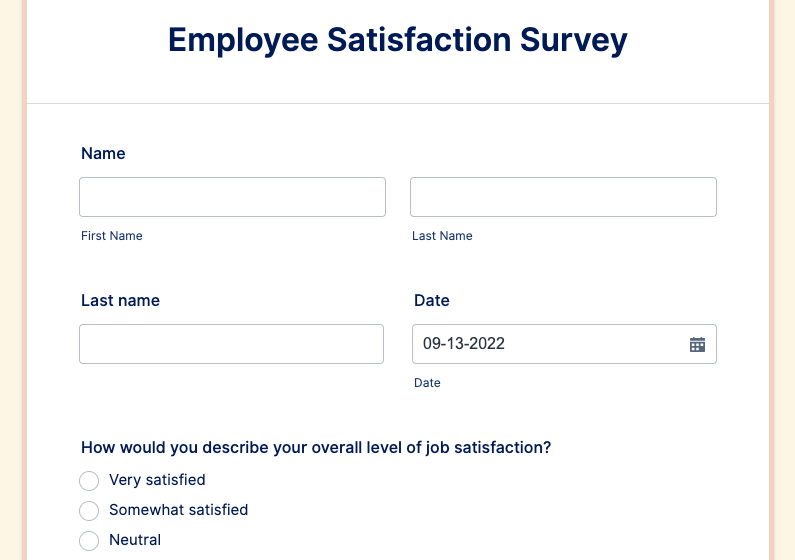Companies of all sizes and industries use surveys to gather valuable feedback from their customers and employees. By providing intel about how and when to make product and service improvements, surveys help businesses boost brand reach, customer engagement, productivity, and, ultimately, profitability.
But to receive valuable feedback from your customers and employees, you have to ask the right survey questions. Here’s a breakdown of closed-ended questions, including an explanation of what they are, when to use them, and helpful examples.
Open-ended questions vs closed-ended questions
When creating surveys or making tests, there are two types of questions you can include: Open-ended questions collect qualitative data, while closed-ended questions collect quantitative data. Qualitative data is descriptive and interpretation based, while quantitative is measurable and numbers based. Though we’ll primarily focus on closed-ended questions, it helps to first understand the difference between the two.
Open-ended questions typically include a large, fillable text box where the respondent can answer (e.g., “What do you think about our customer service?” or “Tell us three things you would change about this product.”). They’re broader than closed-ended questions, require extra thought and elaboration on the part of the respondent, and enable you to get a clearer understanding of what your target audience thinks about your product or service.
Closed-ended questions are more narrowly focused (e.g., “Would you recommend us to a friend?”), and respondents can only answer them by selecting from a short list of multiple-choice or yes/no options. They’re easy to measure, perfect for short surveys, and help you quickly identify trends and percentages specific to a particular topic and audience.
When to use closed-ended questions
In addition to helping you collect actionable, quantitative data, closed-ended questions can be helpful if you’re looking to do the following.
Conduct demographic research
With closed-ended questions, you can better analyze demographics — like gender, age, location, and marital status — to improve decision-making, product design, and marketing campaigns.
Say you own a clothing store and want to know the demographics of your current shoppers so you can extend your brand reach. With a market research survey, you can find out who shops at your store — and specific things they like about it — then create effective ad campaigns to target shoppers like them.
Receive concrete feedback
Unlike open-ended questions, closed-ended questions typically include a specific range of answers (think multiple choice instead of free response). These question types offer concrete and consistent answers instead of varied and unique responses. People are also more likely to respond to closed-ended questions because they take less time to fill out, which can help boost your survey response rate.
Sample a large number of people
Whether you’re manually tallying the responses or collecting and analyzing them with software, closed-ended questions are best for quick, accurate data retrieval when you have a large sample population. It’s easier to analyze a consistent set of responses than longer, essay-styled ones.
Types and examples of closed-ended questions
As you begin drafting closed-ended questions, consider how exactly you want your respondents to answer them. Here are a few types of closed-ended question response options.
Dichotomous or true-or-false questions
With true-or-false (or yes/no and agree/disagree) questions, you can get clear-cut answers to your questions without any subjectivity. They’re easy to answer and quick to measure, but they don’t provide much nuance.
- “Would you shop here again?”
- “I believe this is a clean and well-maintained store.”
- “Were our associates friendly and helpful?”
Multiple-choice questions
Familiar to most respondents, multiple-choice questions are easy to complete. Multiple-choice questions in surveys are commonly divided into two categories: radio choice or checkboxes.
Radio choice
Similar to the multiple-choice questions from our school days, radio choice questions allow survey respondents to select just one answer. In surveys, however, radio choice response options are neither right nor wrong. Instead, respondents just have to choose the answer that aligns most closely with their opinion.
A Likert scale rating system, for example, is a type of radio choice where respondents select from a variation of the following answer choices in response to a statement: strongly agree, agree, disagree, or strongly disagree.
- “I believe this store has high-quality merchandise.”
- “It’s easy to find clothes in my size.”
- “I will shop here again.”
Checkboxes
Checkboxes, on the other hand, allow respondents to choose more than one option as their answer. (Your respondents can also rank their selections from 1–5 or most important to least important.)
- “Which of the following factors influence where you shop? Select all that apply.” (quality products, store cleanliness, friendly staff, etc.)
- “List the following features in order of importance when shopping.” (music selection, free goodies, dressing room size, friendly staff, etc.)
There are many types of closed-ended questions, so it’s important to understand what you’re trying to accomplish with your survey before you choose which to include. The more you understand what you need, the better you can tailor your questions and the more valuable the feedback will be.
Powerful surveys with Jotform
Now that you’ve learned the ins and outs of closed-ended questions, it’s time to actually create a survey. With Jotform, you can build powerful, engaging surveys (either from scratch or by using one of the 850-plus premade templates) unique to your business and specific goal.
Jotform is easy to use, fully customizable, intuitive, and completely code free, helping you make branded, stunning surveys (from employee satisfaction surveys to product survey forms), regardless of coding experience. You can even share, collect, and analyze your surveys — all from one streamlined platform.
Aside from being easy to make — and easy for respondents to complete — online surveys are cost-effective, ensuring you receive valuable feedback that can catapult your business forward at little to no cost. Plus, now that you know more about open- and closed-ended questions and how best to use them, you’re better positioned to create surveys that people will want to complete.







































































































Send Comment:
1 Comments:
310 days ago
I get how to create a survey and how to use it. What you don't tell me is how to observe the resulting survey data? Where do I find it?